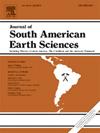2024年5月阿雷格里港大都会区(巴西南部)前所未有的洪水:原因、风险和影响
IF 1.7
4区 地球科学
Q3 GEOSCIENCES, MULTIDISCIPLINARY
引用次数: 0
摘要
2024 年 5 月 2 日,巴西南里奥格兰德州的阿雷格里港发生了历史性的洪水,超过了 1941 年的灾难性事件。这次洪水的最高水位为 535 厘米,比 1941 年高出 59 厘米,其原因是阿雷格里港大都市区的极端降水异常和土地利用变化,2024 年 5 月的累积降雨量高达 500 毫米。严重的城市洪水影响了河岸和低洼地区,造成重大财产损失、流离失所和基本服务中断。农田和草地受到广泛影响。验证样本点确保了数据的准确性,洪水模型验证指标(NSE = 0.63、R2 = 0.71、RMSE = 0.51 米)证明了模型的预测准确性。Cais Guaíba 站的水位波动显示了典型的大洪水快速上升和衰退期。这项研究强调,迫切需要通过准确的建模和风险评估,制定有效的洪水缓解战略,以保护脆弱的社区和基础设施。通过改善城市规划、基础设施投资和环境保护来提高抗灾能力,对于保护阿雷格里港和更广泛的 RMPOA 地区免受未来极端天气事件的影响至关重要。这些发现为其他易受洪水侵袭的热带地区和发展中地区提供了宝贵的启示,在这些地区,城市扩张和极端气候加剧的综合影响同样会增加洪水风险。本文章由计算机程序翻译,如有差异,请以英文原文为准。
Unprecedented flooding in Porto Alegre Metropolitan Region (Southern Brazil) in May 2024: Causes, risks, and impacts
On May 2, 2024, Porto Alegre in Rio Grande do Sul, Brazil, experienced a historic flood surpassing the catastrophic 1941 event. The flood's peak water level of 535 cm was 59 cm higher than in 1941, driven by extreme precipitation anomalies and land use changes in the Regional Metropolitan Area of Porto Alegre, with rainfall accumulations up to 500 mm in May 2024. Severe urban flooding impacted riverbanks and low-lying areas, causing significant property damage, displacement, and disruption of essential services. Agricultural lands and grasslands were extensively affected. Detailed maps from May 3 to May 8, 2024, showed floodwaters rising from 5.5 m to 8 m. Validation sample points ensured data accuracy, and flood model validation metrics (NSE = 0.63, R2 = 0.71, RMSE = 0.51 m) demonstrated the model's predictive accuracy. Water level fluctuations at Cais Guaíba station revealed rapid rise and recession periods typical of major floods. This study highlights the urgent need for effective flood mitigation strategies, informed by accurate modeling and risk assessment, to protect vulnerable communities and infrastructure. Enhancing resilience through improved urban planning, infrastructure investment, and environmental conservation is crucial to safeguarding Porto Alegre and the broader RMPOA region from future extreme weather events. These findings offer valuable insights for other flood-prone tropical and developing regions, where the combined effects of urban expansion and intensifying climate extremes similarly increase flood risk.
求助全文
通过发布文献求助,成功后即可免费获取论文全文。
去求助
来源期刊

Journal of South American Earth Sciences
地学-地球科学综合
CiteScore
3.70
自引率
22.20%
发文量
364
审稿时长
6-12 weeks
期刊介绍:
Papers must have a regional appeal and should present work of more than local significance. Research papers dealing with the regional geology of South American cratons and mobile belts, within the following research fields:
-Economic geology, metallogenesis and hydrocarbon genesis and reservoirs.
-Geophysics, geochemistry, volcanology, igneous and metamorphic petrology.
-Tectonics, neo- and seismotectonics and geodynamic modeling.
-Geomorphology, geological hazards, environmental geology, climate change in America and Antarctica, and soil research.
-Stratigraphy, sedimentology, structure and basin evolution.
-Paleontology, paleoecology, paleoclimatology and Quaternary geology.
New developments in already established regional projects and new initiatives dealing with the geology of the continent will be summarized and presented on a regular basis. Short notes, discussions, book reviews and conference and workshop reports will also be included when relevant.
 求助内容:
求助内容: 应助结果提醒方式:
应助结果提醒方式:


